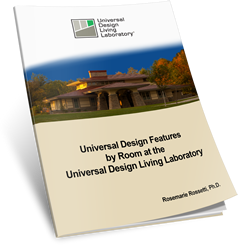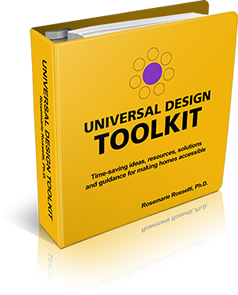
Discover how to live at home more affordably -- with independence, safety and dignity.
Get a sneak-peek at the "Universal Design Toolkit" with this free chapter filled with advice, tips and money-saving resources!

Build your awareness of what universal design features should be incorporated into homes.
Get the newly released "Universal Design Tookit", based on this real life demonstration home.

My Story
 On June 13, 1998 my husband, Mark Leder, and I decided to celebrate our anniversary by going on a bicycle ride. It was a beautiful day with a clear blue sky, perfect biking weather. I was riding down the path ahead of Mark, when he heard a loud crack and yelled, “Look over there something is falling!” I glanced back at him and suddenly a 3 1/2 ton tree came crushing down on me, leaving me injured on the bike path.
My life was changed in that instant!
I was paralyzed from the waist down with a spinal cord injury.
On June 13, 1998 my husband, Mark Leder, and I decided to celebrate our anniversary by going on a bicycle ride. It was a beautiful day with a clear blue sky, perfect biking weather. I was riding down the path ahead of Mark, when he heard a loud crack and yelled, “Look over there something is falling!” I glanced back at him and suddenly a 3 1/2 ton tree came crushing down on me, leaving me injured on the bike path.
My life was changed in that instant!
I was paralyzed from the waist down with a spinal cord injury.
As I lay in the hospital, I was angry, scared and mad at the world. I could not see myself living with this loss. I was in constant pain. I was so weak that Mark had to feed me. I saw my life as wasted! Everything that I had done in my life was a waste! My eight years of college were wasted! How am I going to survive? How are my businesses going to survive? My finances, my business and my marriage are in jeopardy. I could lose Mark, our house, everything!
 I cried over the things that I would never be able to do again, things that I had enjoyed before my injury. Mark and I found togetherness in our recreational activities. We not only loved to ride our bikes, but we loved to ski, hike, dance, and play racquetball.
I thought I would never get to enjoy them with my husband again. I looked deep within myself and found new strength and new resolve to try and rebuild my life. I used the resources that I had available to me. I told my physical therapist “I am willing to work and do anything you say. I want my life back and I will do whatever you tell me”. I pushed myself harder everyday while I was in the rehabilitation center. I wanted to regain the most basic of life skills; feeding myself, grooming, moving in bed, sitting up, pushing myself in a wheelchair.
I cried over the things that I would never be able to do again, things that I had enjoyed before my injury. Mark and I found togetherness in our recreational activities. We not only loved to ride our bikes, but we loved to ski, hike, dance, and play racquetball.
I thought I would never get to enjoy them with my husband again. I looked deep within myself and found new strength and new resolve to try and rebuild my life. I used the resources that I had available to me. I told my physical therapist “I am willing to work and do anything you say. I want my life back and I will do whatever you tell me”. I pushed myself harder everyday while I was in the rehabilitation center. I wanted to regain the most basic of life skills; feeding myself, grooming, moving in bed, sitting up, pushing myself in a wheelchair.
Coming Home - Frustrations Build
 After six weeks of inpatient rehabilitation, I was released. When I arrived home Mark pushed me up a makeshift ramp into the house. I went into my home for the first time as a wheelchair user.
After six weeks of inpatient rehabilitation, I was released. When I arrived home Mark pushed me up a makeshift ramp into the house. I went into my home for the first time as a wheelchair user.
After three years of marriage, Mark was now forced into the position of being my nurse. He got me out of bed each morning. He dressed me and helped me with my personal hygiene. He did the laundry, bought the groceries, did the cooking, yard work, and cleaned our home. He tried to console me but he couldn’t even hold my hand without causing me pain, due to my injury. He tried to make me feel like his wife instead of his patient.
 My two-story dream home was a major source of frustration, limiting my mobility, independence, safety, and comfort. I couldn’t go down the steps into my back yard garden. The entire second floor of my home and the basement were not accessible due to more stairs. I couldn’t reach the dishes in the kitchen cupboards.
My two-story dream home was a major source of frustration, limiting my mobility, independence, safety, and comfort. I couldn’t go down the steps into my back yard garden. The entire second floor of my home and the basement were not accessible due to more stairs. I couldn’t reach the dishes in the kitchen cupboards.
Modifications were made. An electric platform lift was installed at the front porch and the porch surface was raised in order for me to get into our home. Doors were removed on the bathroom, shower, and laundry room to allow me access. Grab bars were installed in the toileting areas. Cabinet and pantry contents had to be repositioned to allow me access to the most critically needed items. Full extension drawers were installed in the lower kitchen cabinets. Long handled reaching devices were placed in every room.
 Although these modifications helped to improve the quality of my life, problems still exist. I can’t go down the steps into the garage to get into my van, so I have to go out the front door, down the lift and around the front walk. When I bring home groceries I have to carry the bags in my mouth while I maneuver down the walk and up the lift. Even getting something out of my freezer requires a trip out the front door.
Although these modifications helped to improve the quality of my life, problems still exist. I can’t go down the steps into the garage to get into my van, so I have to go out the front door, down the lift and around the front walk. When I bring home groceries I have to carry the bags in my mouth while I maneuver down the walk and up the lift. Even getting something out of my freezer requires a trip out the front door.
The laundry room is too tiny to maneuver my wheelchair. I have to use a long handled reacher to remove the clothes from the top loading washer. Rolling on the thickly padded carpet is fatiguing. Some of the closet doorways are too narrow for me to enter, making them inaccessible. Clothing rods are too high for me to reach my wardrobe. The hallways are too narrow for me to turn around in. I can’t use my bathtub and the towel bars are out of my reach.
While in physical and occupational therapy for two years, I began to rebuild my life. I worked to regain the strength necessary to take care of my daily personal needs. A red-letter day occurred when I was able to tie my shoes.
I began to rebuild my business and began speaking, training and writing again. I took lessons in adaptive skiing and wheelchair dancing. Life balance was being restored.
 |
 |
In Search for a Home
After five years, Mark and I realized that our existing home was never going to fully meet my need for independence, so we decided to build a new home. We toured model homes all over the Columbus, Ohio area in search of a lot. We interviewed builders and reviewed floor plans. No universal design features were included in these models and few options were presented to us by the builders. We became very discouraged by the prospect of living in a home that frustrated me and limited my life.
Mark said, “Why can’t anybody understand this, why don’t they think this through and make homes accessible for everyone?”
We both wonder why builders aren’t incorporating universal design into their existing floor plans. Why aren't universal design features and benefits discussed with home buyers to identify their current and future needs? Due to the aging baby boomer population, the housing market has a need for universal design features.
Discovering Universal Design
Mark and I had been collecting information and researching universal design principles since my injury. We learned that universal design is a framework for the design of living and working spaces and products, benefiting the widest possible range of people in the widest range of situations without special or separate design. Universal design is human-centered design, accommodating people of all sizes, ages, and abilities. A home designed with universal design principles certainly makes life easier, not only for those with mobility limitations, but also for those who are young, old, short or tall. We are a good couple to illustrate the need for universal design, as Mark stands at 6’4” and I am 4’2” tall seated in my wheelchair. Universal design is for everyone!
 The US population of baby boomers (78 million) and people with disabilities (54 million) will be able especially able to benefit from universal design. Universal design allows families to age in place.
It is less likely that modifications will be needed to the home to accommodate unexpected injuries and illnesses.
It is much more cost effective to initially design homes utilizing universal design features rather than remodeling a home later.
The US population of baby boomers (78 million) and people with disabilities (54 million) will be able especially able to benefit from universal design. Universal design allows families to age in place.
It is less likely that modifications will be needed to the home to accommodate unexpected injuries and illnesses.
It is much more cost effective to initially design homes utilizing universal design features rather than remodeling a home later.
Seven years of research into the area of universal design transformed us. The process led to a belief that we could share our research and knowledge and our home to make a significant and positive difference in the lives of others. We were passionate about finding a way to share what we had learned with others.
We made a deposit on a home site and looked for the finest design, construction and consulting talent available.
Development of the Universal Design Living Laboratory
We were now on an ambitious campaign to build a national demonstration home and garden. The Universal Design Living Laboratory will be available to the building industry and consumers. The Universal Design Living Laboratory will serve to help people better understand how to create a more comfortable living environment that will enhance their quality of life. This Universal Design Living Laboratory will act as a resource to learn from – today and tomorrow.